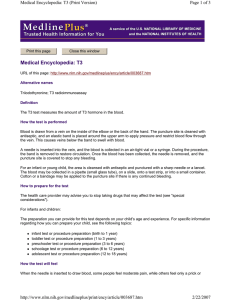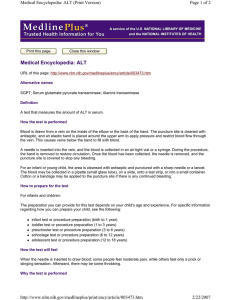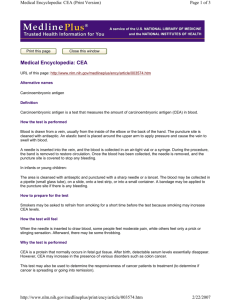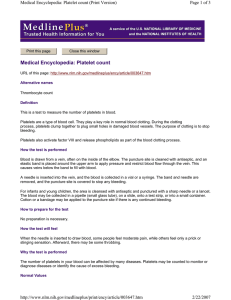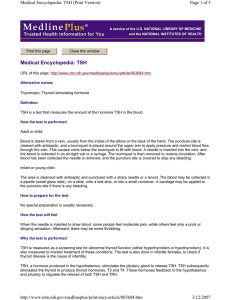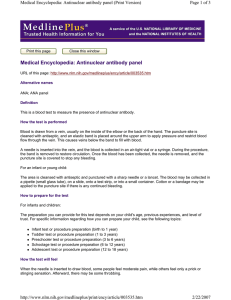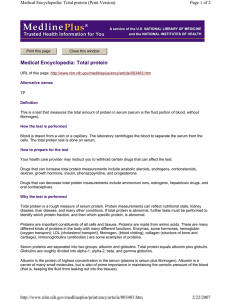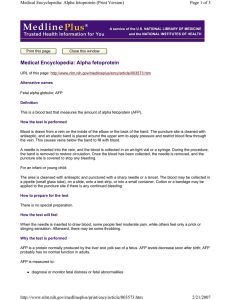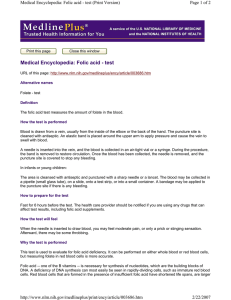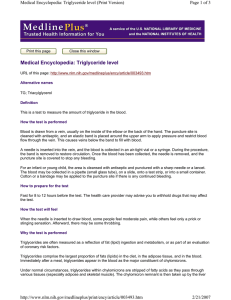Medical Encyclopedia: T4 test Page 1 of 3
advertisement
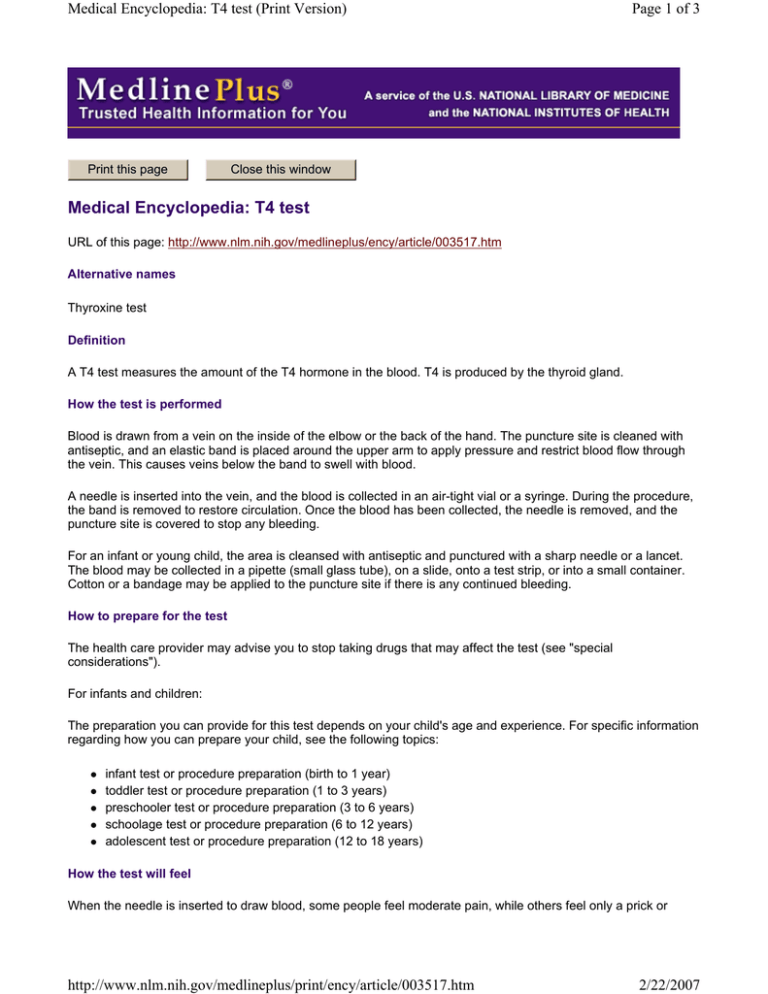
Medical Encyclopedia: T4 test (Print Version) Print this page Page 1 of 3 Close this window Medical Encyclopedia: T4 test URL of this page: http://www.nlm.nih.gov/medlineplus/ency/article/003517.htm Alternative names Thyroxine test Definition A T4 test measures the amount of the T4 hormone in the blood. T4 is produced by the thyroid gland. How the test is performed Blood is drawn from a vein on the inside of the elbow or the back of the hand. The puncture site is cleaned with antiseptic, and an elastic band is placed around the upper arm to apply pressure and restrict blood flow through the vein. This causes veins below the band to swell with blood. A needle is inserted into the vein, and the blood is collected in an air-tight vial or a syringe. During the procedure, the band is removed to restore circulation. Once the blood has been collected, the needle is removed, and the puncture site is covered to stop any bleeding. For an infant or young child, the area is cleansed with antiseptic and punctured with a sharp needle or a lancet. The blood may be collected in a pipette (small glass tube), on a slide, onto a test strip, or into a small container. Cotton or a bandage may be applied to the puncture site if there is any continued bleeding. How to prepare for the test The health care provider may advise you to stop taking drugs that may affect the test (see "special considerations"). For infants and children: The preparation you can provide for this test depends on your child's age and experience. For specific information regarding how you can prepare your child, see the following topics: z z z z z infant test or procedure preparation (birth to 1 year) toddler test or procedure preparation (1 to 3 years) preschooler test or procedure preparation (3 to 6 years) schoolage test or procedure preparation (6 to 12 years) adolescent test or procedure preparation (12 to 18 years) How the test will feel When the needle is inserted to draw blood, some people feel moderate pain, while others feel only a prick or http://www.nlm.nih.gov/medlineplus/print/ency/article/003517.htm 2/22/2007 Medical Encyclopedia: T4 test (Print Version) Page 2 of 3 stinging sensation. Afterward, there may be some throbbing. Why the test is performed This test may be performed as part of an evaluation of thyroid function. Thyroid function is complex and depends on the action of many different hormones: 1. Thyroid-stimulating hormone (TSH) is a secreted by the pituitary gland. 2. TSH causes the thyroid gland to produce two more hormones, T4 (thyroxine) and T3 (triiodothyronine). 3. Finally, TSH itself is stimulated by another hormone, thyroid-releasing hormone (TRH), which is made by the hypothalamus. In people with normal thyroid function, having enough T3 and T4 inhibits both TSH and TRH, which prevents the body from making too much T3 and T4. T4 levels are important, because T4 increases numerous enzymes that produce energy for the body. Most T3 and T4 is transported by a protein called TBG (thyroxine binding globulin), but smaller amounts are found on prealbumin and albumin. When not bound to proteins, they are called "free" T3 or T4. Normal Values Normal values vary among different laboratories. A typical normal range is: 4.5 to 11.2 mcg/dL (micrograms per deciliter). What abnormal results mean Greater-than-normal levels of T4 along with low levels of TSH may indicate hyperthyroid conditions, such as: z z z z z z z Graves' disease toxic multinodular goiter subacute or chronic thyroiditis early Hashimoto's disease iodine-induced hyperthyroidism germ cell tumors trophoblastic disease Lower-than-normal levels of T4 may indicate: z z z z hypothyroidism (including Hashimoto's disease, cretinism, myxedema, goitrous diseases, scleroderma, amyloid goiter, or hemochromatosis following neck irradiation for head and neck cancer) malnutrition or fasting illness throughout the body use of certain prescribed medication, including dexamethasone, propranolol, lithium, iodine, methimazole, propylthiouracil, interferon alfa, interleukin-2, and amiodarone Additional conditions under which the test may be performed: z z z z hypopituitarism hypothyroidism - primary hypothyroidism - secondary thyrotoxic periodic paralysis http://www.nlm.nih.gov/medlineplus/print/ency/article/003517.htm 2/22/2007 Medical Encyclopedia: T4 test (Print Version) Page 3 of 3 What the risks are Risks associated with having blood drawn are slight: z z z z z excessive bleeding fainting or feeling lightheaded hematoma (blood accumulating under the skin) infection (a slight risk any time the skin is broken) multiple punctures to locate veins Special considerations Drugs that can increase T4 measurements include clofibrate, estrogens, methadone, amiodarone, and birth control pills. Drugs that can decrease T4 measurements include anabolic steroids, androgens, antithyroid drugs (for example, propylthiouracil and methimazole), lithium, phenytoin, propranolol, amiodarone, interferon alpha, and interleukin2. Veins and arteries vary in size from one patient to another and from one side of the body to the other. Obtaining a blood sample from some people may be more difficult than from others. Update Date: 1/18/2006 Updated by: Nikheel S. Kolatkar, MD, Clinical and Research Fellow, Division of Endocrinology, Diabetes, and Hypertension, Brigham and Women's Hospital, Harvard Medical School, Boston, MA. Review provided by VeriMed Healthcare Network. A.D.A.M., Inc. is accredited by URAC, also known as the American Accreditation HealthCare Commission (www.urac.org). URAC's accreditation program is the first of its kind, requiring compliance with 53 standards of quality and accountability, verified by independent audit. A.D.A.M. is among the first to achieve this important distinction for online health information and services. Learn more about A.D.A.M.'s editorial process. A.D.A.M. is also a founding member of Hi-Ethics (www.hiethics.com) and subscribes to the principles of the Health on the Net Foundation (www.hon.ch). The information provided should not be used during any medical emergency or for the diagnosis or treatment of any medical condition. A licensed physician should be consulted for diagnosis and treatment of any and all medical conditions. Call 911 for all medical emergencies. Adam makes no representation or warranty regarding the accuracy, reliability, completeness, currentness, or timeliness of the content, text or graphics. Links to other sites are provided for information only -- they do not constitute endorsements of those other sites. Copyright 2005, A.D.A.M., Inc. Any duplication or distribution of the information contained herein is strictly prohibited. http://www.nlm.nih.gov/medlineplus/print/ency/article/003517.htm 2/22/2007
